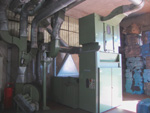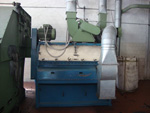Blending
To obtain a yarn that is uniform, strong and regular, it is essential that the component fibres are optimally blended. This phase of processing intensively boosts the opening of the material, ensuring cleanliness and at the same time enhancing the degree of blending.
Opening of the bales: the bales of raw wool are unwrapped, fed to the bale-opener on a conveyor belt and arranged in two rows.
Scouring: from the bale-opener, the fibres are transported pneumatically to the beater, which “opens” the wool and removes dust and various impurities.
Opening the wool: a carding machine called the lupo apritore on account of its sharp teeth is used to open the fibres of the wool material.
Oil emulsioning: the oiling of the blend is of fundamental importance since it increases the coefficient of friction between the fibres, enhancing the cohesion between the card web and the rovings and reducing that between the material and the metallic gaskets of the machines.
Blending: after the oil emulsioning, the wool is conveyed to the blending rooms, where the characteristic horizontal laying of the fibres takes place. This is followed by breakdown into a large number of layers, each fairly fine, so as to optimise blending through the subsequent vertical extraction.
Extraction via bin emptier: extraction of the fibres is performed using a moveable bin emptier which runs along tracks picking up fibres all the way along, inside the bin.
Storage and delivery to carding: from the blending section, the wool may be returned to the carding machines for further opening of the fibres or, if it needs to be further homogenised, may go through a second or even third blending operation followed by extraction, before being finally delivered to the carding area.
Opening of the bales: the bales of raw wool are unwrapped, fed to the bale-opener on a conveyor belt and arranged in two rows.
Scouring: from the bale-opener, the fibres are transported pneumatically to the beater, which “opens” the wool and removes dust and various impurities.
Opening the wool: a carding machine called the lupo apritore on account of its sharp teeth is used to open the fibres of the wool material.
Oil emulsioning: the oiling of the blend is of fundamental importance since it increases the coefficient of friction between the fibres, enhancing the cohesion between the card web and the rovings and reducing that between the material and the metallic gaskets of the machines.
Blending: after the oil emulsioning, the wool is conveyed to the blending rooms, where the characteristic horizontal laying of the fibres takes place. This is followed by breakdown into a large number of layers, each fairly fine, so as to optimise blending through the subsequent vertical extraction.
Extraction via bin emptier: extraction of the fibres is performed using a moveable bin emptier which runs along tracks picking up fibres all the way along, inside the bin.
Storage and delivery to carding: from the blending section, the wool may be returned to the carding machines for further opening of the fibres or, if it needs to be further homogenised, may go through a second or even third blending operation followed by extraction, before being finally delivered to the carding area.









